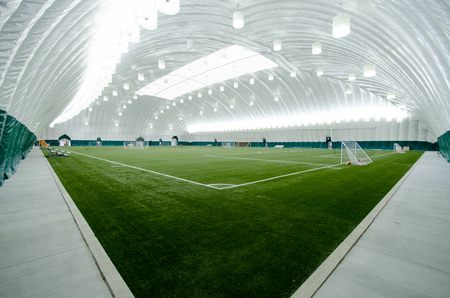
We collect basic website visitor information on this website and store it in cookies. We also utilize Google Analytics to track page view information to assist us in improving our website.
Sorry to burst your bubble, but not everyone has stepped into an air-supported structure. As a result, there can be some interesting, funny, or wacky preconceptions about what it’s like inside of a dome. While the basic principles behind keeping a bubble inflated aren’t too complicated, the impressive nature of the structures can make understanding what is going on a little counterintuitive.
Here are a few dome myths and misunderstandings that even you might have.
Air Pressure is Strong in a Dome
This is a pretty common one. “If I step into an air dome, will I be crushed by the air pressure?” It seems silly if you’ve ever been inside of a dome, but for those that have never stood in one, it is a concern.
Without getting into the physics and math—we’ll save that for another day—the air pressure required to keep the dome inflated is actually quite small. You likely experience greater differences in air pressure when driving through particularly hilly areas. The variation might even be as small as that which you’d experience in a daily basis as the barometric pressure fluctuates throughout a day.
So, no, you aren’t going to be crushed by air pressure when you enter a dome and the slight increase isn’t near enough to be worried about.
It’s Dark Inside Bubbles
There is one thing that a dome is often missing: windows. It’s easy to assume that it must be dark inside then, right? Like a deep, cavernous, expanse of dark space?

Wrong! The inside of a dome can actually be quite bright. Most sports—if not all—need lots of light for optimal playing conditions, so the lighting systems are meticulously developed. The shape of a dome works amazingly to direct light back down towards the playing surface. Coupled with a highly reflective inside layer of fabric, light bounces back to where it needs to be for maximum visibility.
There’s no worry about missing that corner cross or squinting to see a serve. When those bubble lights are on, you won’t miss a thing.
Domes are Fragile
Another common misconception about domes is that, since they are made of fabric, they must be prone to rips and tears. When you couple this myth with that of high-pressure in a dome, it seems a wonder that bubbles aren’t bursting all over the place!
The reality is that tears don’t happen unless there is some major trauma going on. Extremely high winds, heavy object collisions (like a car or machinery), or vandalism with a knife are what usually do it.
When a dome is damaged, it rarely results in a structural failure. When a tear happens, an alarm will accompany the pressure drop, giving occupants plenty of time to either find the problem, or step outside. A simple patch job then follows, and you’re back in business.
Domes can be gigantic and anything impressive can inspire imaginative thinking. This is why we take it as a compliment when we hear interesting ideas as to how they work, even if those ideas are wrong! Dome myths are fun to explain and set straight so keep an eye out for future articles that go even deeper into some of the wackier myths about air structures.
